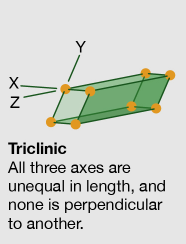Hexagonal System = Components of crystals in this system are located by reference to four axes - three of equal length set at at 120° to one another and a fourth axis perpendicular to the plane of the other three.
The hexagonal unit cell is distinguished by the presence of a single line, called an axis of 6-fold symmetry, about which the cell can be rotated by either 60° or 120° without changing its appearance.
All crystals in the hexagonal system are classed as optically uniaxial, meaning that light travels through the crystal at different speeds in different directions.
All crystals in the hexagonal system are classed as optically uniaxial, meaning that light travels through the crystal at different speeds in different directions.
Isometric System = It is also called cubic system . Crystals in this system are referred to three mutually perpendicular axes of equal lengths. The isometric unit cell is distinguished by four lines, called axes of threefold symmetry, about which the cell can be rotated by 120° without changing its appearance. This characteristic requires that the cell be a perfect cube; the threefold axes are the diagonals of the cube. A cube has six square faces, but many of the crystal forms in the isometric system display more complex configurations; among the most symmetrical forms of the isometric (or cubic) system are the octahedron (8 faces), trisoctahedron (24 faces), and hexoctahedron (48 faces).
Monoclinic System = Crystals in this system are referred to three axes of unequal lengths—say, a, b, and c—of which a is perpendicular to b and c, but b and c are not perpendicular to each other.
The monoclinic unit cell is distinguished by a single axis, called an axis of twofold symmetry, about which the cell can be rotated by 180° without changing its appearance.
Orthorhombic System = Crystals in this system are referred to three mutually perpendicular axes that are unequal in length. The orthorhombic unit cell is distinguished by three lines called axes of twofold symmetry about which the cell can be rotated by 180° without changing its appearance. This characteristic requires that the angles between any two edges of the unit cell be right angles but the edges may be any length.
Triclinic System = Crystals in this system are referred to three axes of unequal lengths that are inclined at nonorthogonal (nonperpendicular) angles relative to each other.
Trigonal System = The trigonal system is sometimes considered to be a subdivision of the hexagonal system.
Components of crystals in the trigonal system, like those of the hexagonal system, are located by reference to four axes—three of equal length with 120° intersections and one perpendicular to the plane of the other three. The trigonal unit cell is distinguished by the presence of a single line called an axis of three-fold symmetry about which the cell can be rotated by 120° to produce a face indistinguishable from the face presented in the starting position.
Components of crystals in the trigonal system, like those of the hexagonal system, are located by reference to four axes—three of equal length with 120° intersections and one perpendicular to the plane of the other three. The trigonal unit cell is distinguished by the presence of a single line called an axis of three-fold symmetry about which the cell can be rotated by 120° to produce a face indistinguishable from the face presented in the starting position.












No comments:
Post a Comment